-
SPOO/POKOT ( Agnieszka Holland, Kasia Adamik 2017)
AGNIESZKA HOLLAND, KASLA ADAMIK: SPOOR/POKOT (2017)
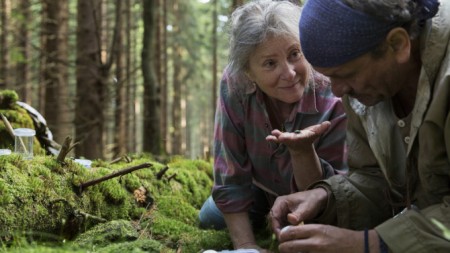
AGNIESZKA MANDAT IN SPOOR
Admiration for a crazy lady
From a novel, this new movie by Agnieszka Holland and her daughter expresses an intense, boisterous, and rather disturbing admiration for a vigorous nut case of a lady in late middle age, Janina Duszejko (Agnieszka Mandat) - she has to tell people not to put an "n" in the name and insists they just call her "Duszejko," never "Janina" or "Ms." A great admirer of the doctrines of William Blake, she lives in Kotlina Kłodzka, a virtual nature preserve on the Polish-Czech border that's not a preserve at all: its bristling with birds, wild boar, deer and other wildlife, but the macho local culture involves constant hunting and poaching - killing out of season that "Duszejko" abhors. Correspondingly, the story is punctuated by hunting rules, with title cards showing what animals are in season month by month and what ones aren't, through winter to summer and back to winter again.
This looks like the chronicle of an eccentric woman in her sixties who becomes the suspect/ad hoc investigator of a crime story as a series of murders occur, but it turns into an animal activist drama whose hero gets away with murder. It's suggested, in passing, that astrology, a big hobby of Duszejko's, is a good thing too. This is impressive, boisterous filmmaking, full of noise, action, and life. It's also sprawling and troubling in its apparent advocacy of questionable strategies. Spoor is an oddball work by a famous director, a curiosity, a genre-bender, that may find and hold its own niche.
The key apparently lies in the source novel by Olga Tokarczuk, her 2009 Drive Your Plough Over the Bones of the Dead. Tokarczuk is a both critically acclaimed and commercially successful writer who seems to have a strong bent for provocation. Speaking of her more recent 2014 The Books of Jacob, bluntly depicting Polish treatment of the Jews, the Economist reports how she has had abuse heaped upon her by the country's new conservative patriots. Drvive Your Plough is likewise described in a Polish lit website in English as having caused a good deal of "consternation among Polish readers" for "turning to popular literature" with a novel in the "crime genre," focusing on a "central character" who's hard to take, and by the additional claim that the book is a "metaphysical thriller" and therefore somehow resonant with prfound meaning. Judging by this film, there's kookiness where that profundity should be.
One reviewer of the film pointedly claims that the lead actress, Agnieszka Mandat, looks like Aileen Wuornos. But she may as much resemble the director herself, as her daughter rather resembles her. Duszejko admits she's unqualified to teach but is a part-time instructor to school kids in English to keep busy. She lives off by herself in a rough but rangey cottage with two big female dogs. She starts breaking the rules when the dogs disappear by bringing out her class in the middle of the night to hunt for the dogs. She is bereaved, and doesn't get over it, and rails against all the men in authority and power around town - the richest man, the mayor, the chief of police, the local priest. We get the message pretty bluntly when the priest condemns Duszejko's pet cemetery, firmly declaring that animals have no souls.
Killings are dotted through the year. When the hot weather comes, Duszejko meets up with an entomologist doing research in the woods(Miroslav Krobot) and they have a lively and vigorously physical late-blooming affair that's also a union of activists against the world. The entomologist rails against the loggers who are killing off the larvae of insects that are essential to the ecology of the region - of the planet.
Mandat is impressive, alternately scary and beautiful, and carries the action well. Spoor's energy and flow are fun and impressive. At its best moments, the film effortlessly conveys a sense of burgeoning nature and human events out of control. But it feels out of control too, its police procedural element never providing the pace and backbone it might. Filmmaking skills come to feel wasted in the repetitiousness and excessive length. Spoor frequently harangues the viewer with its - or Tokarczuk's - feminism and ecological activism. The score by Antoni Komasa-Lazarkiewicz, typically, is hard-driving and energetic but a bit monotonous too. Peter Bradshaw is on target when he calls Spoor "watchable in its quirky and wayward way, with some funny moments – [but] shallower than it thinks." Its provocations only weaken its arguments and one wonders if in their enthusiasm Holland and her daughter-collaborator have lost whatever subtlety the novel source may have had.(Metacritic rating: 61%/)
Spoor/Pokot, 128 mins, debuted at the Berlinale; a dozen-plus other festivals. Screened for this review as part of the New York Film Festival, 30 Sept. 2017, with a Q&A by the filmmakers afterwards.
Last edited by Chris Knipp; 10-01-2017 at 11:24 AM.
-
WESTERN (Valeska Grisebach 2017)
VALESKA GRISEBACH: WESTERN (2017)
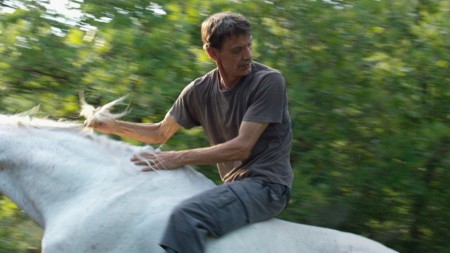
MEINHARD NEUMAN IN WESTERN
Portrait of an estranged loner
One should be wary of a filmmaker's expressed intentions when watching her film: so with Valeska Grisebach's Western, whose title, both explicit and playful, it's best to ignore. The main character looks a bit like a cowboy hero, and there's macho competition, even a horse, but different things are going on from what you'll find in the Hollywood genre. These are Germans working on a water system construction project in a rural part of Bulgaria. The "newbie" in the group is Meinhard (Meinhard Neumann), a tall, grizzled non-actor with a moustache somewhat resembling Sam Elliott, who, despite little knowledge of Bulgarian spends a lot of his time connecting with the locals, with complicated consequences that have more to do with the European Union than with the Wild West.
In the end the genre aspects do come to life, but in a highly original, contemporary way, and without the satisfying resolutions of the traditional genre - a difference that has both good and bad aspects. There are many specific, interesting scenes here, but it might have helped to locate them within a more focused dramatic structure. Despite its several interesting characters, Western winds up feeling patchy and diffuse. It's hard to say what this is all about - it's left unresolved, but the fascination is with the joys and shortcomings of communicating without language and stuff that happens when strangers are planted in a place like this.
Meinhard is the main focus, along with several Bulgarian women he connects with (Veneta Fragnova, Viara Borisova); Adrian (Syuleyman Alilov Letifov), the Bulgarian male who becomes his local "best friend;" and the boorish German crew boss Vincent (Reinhardt Wetrek). Meinhard is wordlessly repelled by Vincent and his coworkers at the outset and seems to spend much of his time exploring: in fact a weakness of the film is that it conveys little sense of the actual work done by the Germans or for Meinhard's part in it.
A white horse wanders wild and free, and Meinhard manages to ride it bareback. As a sign of local conflicts and implied "colonialism" or at least condescension and economic nationalism, Vincent plants a German flag on top of a tall pole at the work site - which quickly disappears. Some of the Bulgarians harbor old resentments, while the Germans talk about finally being back "after seventy years." Meinhard emerges as a "legionnaire" who did unexplained stints in Afghanistan or Iraq, with no home to be homesick about, no family, no wife, no kids, lonely, longing for connection, his estrangement from his fellow Germans on the work crew a sign he may not be good at really connecting for long. He puts on nice shirts in the evening and goes into town, spruced up, ready to charm and make nice - for a while. In the end, Adrian gives back the knife he's gifted to his son, Wanko (Kevin Bashev) saying "He doesn't need this," and asks pointedly, "What do you want here?" (Subtitles translate both languages for us, somewhat blurring the effect of the non-verbal communications.)
The film has a documentary realism and often seems real, disturbingly so in an incident that occurs with a horse. Mostly this reads as an unusual study of how people communicate when they have hardly any language in common; or long-held national prejudices; of conflicts between outsiders and locals. And it's a somewhat enigmatic study of Meinhard, a loner searching for connection - who makes remarkable progress in making local friends that comes in handy when the Germans encounter hostilities, but winds up still a stranger to everyone, though we share with interest in his bold and intriguing little adventures.
Western 120 mins., debuted in the Un Certain Regard series of Cannes 2017. Screened for this review as part of the New York Film Festival shown at 8:30 pm 1 Oct. 2017 at Elinor Bunin Theater, Lincoln Center. The director and actor Syuleyman Alilov Letifov were on hand for a Q&A with Programming Director Dennis Lim. The film will be released later by Cinema Guild.
Last edited by Chris Knipp; 11-18-2017 at 08:01 AM.
-
ZAMA (Lucrecia Martel 2017)
LUCRECIA MARTEL: ZAMA (2017)

DANIEL GIMÉNEZ CACHO IN ZAMA (THE ACTOR'S PARENTS WERE EXILES FROM SPAIN)
A strange and inventive slow burner, long awaited and long delayed
Based on a 1956 novel by Antonio Di Benedetto, which in her country is a cult classic, this is Argentinian director Lucrecia Martel's first feature in nine years, since The Headless Woman (NYFF 2008), which had followed the much admired 2001 La Ciénaga and 2004 The Holy Girl. The story set in the late eighteenth century focuses on a petty official of the Spanish crown, Diego de Zama (Daniel Giménez Cacho), living in a remote outpost on the Paraguay river, endlessly awaiting transfer to Buenos Aires that never comes. "While not much happens (star Daniel Giménez Cacho largely wanders around, perplexed, under a three-cornered hat), when it finally does, it’s violently unsettling. This hallucinatory work vaguely suggests a stoned, swampy relative of 1970s Werner Herzog, but invents its own cinematic language," wrote Jonathan Romney in the Guardian from Venice when the film debuted. And that's an understatement. The ending is apocalyptic and deeply ironic, a sort of "don't ever go to live where there are natives" message. The film is slow going much of the way, but nobody can complain it lacks drama at the end. It's jazzed up with periodic popular music that reminded me of Wong Kar-wai's Happy Together.
Zama is full of enigmatic and inconclusive scenes and colorful, made-up period details and it revels in exoticism; the cinematography is handsome, the color gorgeous. Martel has explained that since the novel source supplies little physical detail, she immersed herself in a lengthy book by an eighteenth-century writer, but would up making much of the detail up. Much is made of wigs, and men are constantly seen taking them off and putting them back on. A governor has red painted nails and wears, supposedly, the ears of an executed wrongdoer on strings around his neck; a tall black slave wears a long blue dress coat and a loin cloth. In the opening scene, richly conveying a sense of strangeness, Zama lies in the bushes watching a group of naked white women by the water covered with mud who yell "voyeur" at him. When he beats a retreat one runs up and grabs his leg. He smacks her away, very hard This is intended to convey that he is not a nice man. Though he's a victim, it's not certain he doesn't deserve his fate. He has a wife, and kids who are growing up without him, in Buenos Aires, but maybe they're better off without him. Maybe colonialism and macho sexism deserve purgatorial sufferings.
An English translation of the book by Di Benedetto was recently published by The New York Review of Books, and there is a 5,000-word review of it by J.M Coetzee in the 19 Jan. 2017 issue of the magazine. From Coetzee's summary I learned details that weren't clear in the film, notably why Zama has been demoted and is always longing for the earlier days when he was a corregidor addressed as "Doctor" with his own district to run. It's because Spain has instituted a new, tighter and more centralized administrative system requiring that officials be Spanish-born, and Zama is an americano, born in the New World, so he is now doomed to be forever second in command.
A long conversation between Zama and a bewigged, dressed up and luridly made up lady focuses on their longing to be somewhere European, where people don't sweat all the time. This is a flirtation, but a useless one. He has a native woman and squalling child. Now he refuses to go to a brothel because he'll only have sex with a white woman; or at least so he says. His dream of a love life is unfulfilled like his dream of escape to a more civilized place - in the film, anyway.
Martel's adaptation of the book leaves out sexual details, while adding attractive visuals like a superb palm-strewn swampland and llamas around the corner in doorways. The novel is a first-person narrative, which has been dropped. In the Q&A Martel said everything that happens and all the dialogue is the first person narration of the film. But despite an impressive mise-en-scène and editing that flows with confidence, the self-conscious complexity of the central character has been subsumed into something more stoical and stolid, just as narrative action has to some extent been subsumed into exotic scene-staging in which the somewhat tricky chronology becomes only harder to follow.
At one point clearly the action jumps forward to some years later when Zama is bearded and older looking. Zama is transferred to a worse outpost, but some of the same people are sent to be with him. He has a widow as a lover now, who lives apart, and has born him a sickly son. Much is made of a young man, Manuel Fernández (Nahuel Cano) who's writing a book on, as it were, company time, and the gobernador wants Zama to read the book, and get rid of Manuel Fernández, but he's uncooperative. Much is made, in Di Benedetto's book (according to Coetzee) of the riddle of a woman, or two women, in a house where Zama takes up residence because he's low on money. But, Coetzee reports, the novel, though long in gestation (which fits with Lucrecia Martel's experience with this film), was hastily written, and this means details are confusing, especially in the third part.
It would remiss not to mention the story's mysterious, recurrent villain, Vicuã Porto (Matheus Nachtergaele), Zama's nemesis, who's mentioned early on but never appears in person - or appears to - until the final scenes. He's not just Zama's nemesis but "a bandit of mythical status—no one is even sure what he looks like—on whom all the colony’s woes are blamed." His story is somewhat simplified from the novel's version, but he's constantly referred to, and enters, in one incarnation, for a decisive encounter with Zama and others sent to combat him, at the end.
Zama is an exotic, delicious to look at, slow-moving but fast-ending film that isn't fully satisfying the first time and might require repeated viewings, preferably in combination with study of Di Benedetto's novel, now finally available to Anglophone readers and clearly requiring careful study in its own right. It's not certain that Zama the film can ever be fully satisfying, but one can revel in its imagery and ponder its meanings.
Zama, 115 mins., debuted at Venice Sept. 2017 and is Argentina's Best Foreign Oscar entry. A half dozen international festivals including Toronto, Haifa, London, Busan and the New York Film Festival, as part of which it was screened for this review in Alice Tully Hall at Lincoln Center 2 Oct. 2017 followed by a Q&A with Martel and NYFF programmer Dennis Lim.
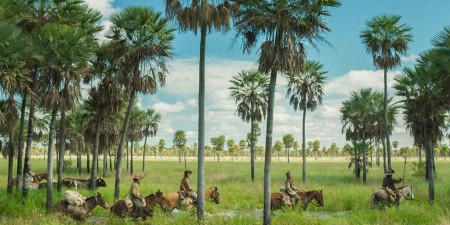
A STUNNING LANDSCAPE FROM LATE IN THE FILIM
Last edited by Chris Knipp; 11-18-2017 at 08:13 AM.
-
CALL ME BY YOUR NAME (Luca Guadagnino 2017)
LUCA GUADAGNINO: CALL ME BY YOUR NAME (2017)
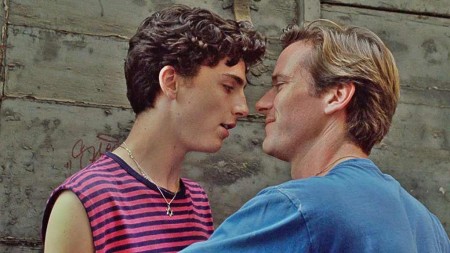
TIMOTHÉE CHALAMET AND ARMIE HAMMER IN CALL ME BY YOUR NAME
Summer love
Many lovers of André Aciman's intense 2007 gay romance (plus coming out and coming of age) novel set in 1983, Call Me by Your Name, are embracing James Ivory's screen adaptation, directed by Luca Guadagnino. And one can see why. The combination, along with Armie Hammer as Oliver, the 23-year-old visiting research assistant, and Timothée Chalamet as his professorial host's bright, ripe teenage son Elio, seems just about perfect - especially since the Ivory-Guadagnino adapting team have wisely chosen to keep the novel's sometimes overwrought, over-analyzing first-person intensity more on the light and "frothy" side - without tempering the sensuality. Chalamet in particular is a revelation, but his young-guy role is ably anchored in the gay love story by the 6'5", deep-voiced Hammer. Both throw themselves into the brief but intense summer romance set in northern Italy, providing the core of what turns out to be a beautiful film, Guadagnino's most straightforward effort and greatest success so far.
The romance, with its strong (yet somewhat vague) physical, sexual side, is the thing, a sort of youthful explosion both sudden and long-awaited. The delay, filled with Elio's endless questioning and self-doubt about whether he likes Oliver or Oliver likes him, when the mutual attraction turns out to have been there from the first - this is deftly conveyed by Ivory's dialogue in a single conversation, making up for all those agonizing and teasing inner monologues in the book, though in the movie as in the book it's halfway through before the two guys even kiss.
What's lost is the emotional richness and sadness of the novel's years- and even decades-later followups that show this affair was the love of Elio's life, while Oliver moved on and (clear in the film) got married very soon after, not that the affair didn't mean a lot to Oliver too. This is where a novel - especially by an avowed Proustian, indeed Proust scholar - can provide intellectual subtlety a film lacks. But what Guadagnino can provide, as he showed in his impressive feature debut I Am Love/Io sono l'amore, is pulsating physicality. Every soft boiled egg, every cup of coffee, every dip in the lake and boyish erection is savored, while many moments are heightened by a background of Elio's intensified keyboard playing.
Chalamet arrives with a delicate beauty plus a dash of bravado, and quite a skill set. Elio, and so Chalamet, is fluent in English, French and Italian, dances with abandon, smokes with panache, makes love to a young woman, Marzia (Esther Garrel), plays piano and guitar, and has sex with a (large, ripe) peach. That last act may be his greatest challenge, but the actor is also, impressively, closeup on camera for the long final shot where he smiles and weeps and turns away, his face alone conveying the novel's last chapters' messages. Early on, he plays a Bach air on guitar and when Oliver requests a keyboard version, improvises it in three different styles. But Hammer as Oliver too is an impressive mix, hunk as smart as ephebe, casual with his trendy salutation, "Later," physically relaxed and friendly, but dazzling in his etymological knowhow.
It's an Italian but also international setting, a splendid summer and holiday house with a cook and gardener-driver, the nearby towns vague in the novel but apparently shot around Lucca for the movie, the place inherited, one gathers, by Elio's mother (Amira Casar). This is where Guadagnino comes through especially, since he is assured with the local people and atmosphere, including a comical couple arguing over politics in Italian at an alfresco home dinner party (in the novel these are nightly).
It isn't forgotten that both Oliver and Elio's family are Jewish, though Elio says his mother (for local consumption in this Italian town without minorities) - and this is 1983, after all, a fact subtly conveyed throughout - are "Jews of discretion": they don't broadcast it. A nice detail is that when the relationship gets going Elio breaks out a little gold Star of David he has like Oliver's and wears it around his neck as a token. Not that in the movie some details from Aciman's novel don't become a bit fuzzy, including the two young men's relationships with young women, Oliver's poker-playing in town, the identities of the cook, Mafalda (Vanda Capriolo) and gardener-driver, Anchise (Antonio Rimoldi) - while Oliver's scholarly accomplishments come across early on as a stunt, like Elio's keyboard acumen.
What to me seemed over-emphasized in the film's shortened context is the almost sermonizingly "understanding" speech of Elio's father (Michael Stuhlbarg) after Oliver is gone, about the relationship he and Oliver have had. It seems also unnecessary on the two guy's short final trip together to inject sequences of spectacular nature, when the novel has them in Rome. But these flaws don't keep the movie from feeling like a success that touches us and leaves one with much to ponder. This is a rather ideal novel adaptation that makes one feel why such things are worth doing.
And this one has a special resonance. I can find no better way to end than the conclusion of Jordan Hoffman's own admirably specific Guardian review: "Call Me By Your Name is a masterful work because of the specificity of its details. This is not a love story that 'just happens to be gay'. The level of trust and strength these characters share brings a richness that is not necessarily known to a universal audience. But the craft on display from all involved is an example, yet again, of how movies can create empathy in an almost spiritual way. This is a major entry in the canon of queer cinema."
Call Me by Your Name, 132 mins., debuted at Sundance and Berlin Jan. 2017, showing in at least two dozen festivals. Screened for this review at the New York Film Festival Tues. 3 Oct. 2017 at Alice Tully Hall, Lincoln Center, with a Q&A involving Luca Guadagnino, Armie Hammer, and Timothée Chalamet and a typically enthusiastic audience. People love this movie. And so do critics: Metacritic rating 97% [4 Oct. 2017; now 93% [11 Jan. 2018). US theatrical release 24 Nov. 2017.
Last edited by Chris Knipp; 01-11-2018 at 07:24 PM.
-
FACES PLACES/VISAGES, VILLAGES JR, (Agnès Varda, 2017)
JR, AGNÈS VARDA: FACES PLACES/VISAGES, VILLAGES (2017)
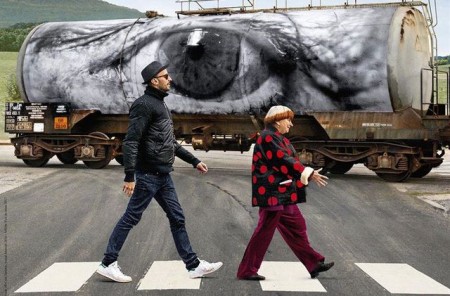
JR and Agnès Varda in Faces Places
Façades
French cinematic icon Agnès Varda, as I noted about her beautiful 2008 documentary self-portrait, The Beaches of Agnès (Rendez-Vous 2009) , likes to be told what she wants to hear. So rather than a "documentary" her new film made with 33-year-old photo installation artist (or photographer/muralist) JR is best seen as aa beautifully staged presentation. It is a showcase for her and JR. In fact they work out a duo act, and a very smooth one it is. They join up to travel around France doing what he does. He has a Mercedes van painted to look like a giant camera, in which he can quickly process photographs and make very large prints suitable to be plastered on walls, which is what they do.
Along the way the 88-year-old but very vigorous (if fragile) Varda calls the shots. And in any case, she is the star, the little stocky woman draped in scarves with the casque of hair, half white, half dyed (this time) a reddish brown. If anyone objects to this plastering of big photos on walls for legal or personal reasons, it's not shown. If this sounds like objections to Varda or JR or their film, they're not. Visages, Villages is a charming, rather magical little film, and a portrait of French niceness. Everyone in this film is polite, good tempered, and friendly. Vive la France! This Tour de France has some of the childlike charm of Michel Gondry's films and is admirable for its purity and simplicity, a celebration of the transitory, of faces and places, of photography and the amiable and attractive defacement of property by artistic people.
The narration of Visages, Village is a running dialogue of JR and Agnès. They too are unfailingly nice - in one conversation he explains why he likes older people, and so, her - she's a little feisty, objecting to a compliment on her wrinkles (when her eyes and her hands get the giant-photo treatment, pasted on freight cars), and to a friend being called "an old friend." They visit JR's 100-year-old grandparent (she hasn't that much to say). Old age is a topic: Varda says she is ready to go and thinks a lot about death (but there's nothing gloomy about this indomitable femme).
JR has a team of assistants, but on the trip we don't get to meet them, only JR, in his hipster hat and highschooler clothes and perpetual shades, which Varda keeps nagging him to take off (eventually he does, but we see his eyes as a blur, because her vision is blurry). We see the pair traveling in the van. They may not be alone in it and surely don't sleep in it, but where they sleep isn't shown. How JR makes his prints and what kind of prints they are also isn't shown or explained. They go around pasting large photos on façades of (usually old) buildings, in the country, in "villages." Once the face of a woman who's the sole remaining inhabitant of a row of devastated houses is pasted on the façade of that house where she remains. (She is moved.)The photographic paper seems thin and it fits between the cracks of a brickwork front.
They meet a farmer who talks about how agriculture has changed. He enjoys helming a tractor with lots of computer gadgets, but misses the other farm hands, who now aren't needed. JR does his portrait, and puts it on a barn-like structure. Later JR and Agnès visit and photograph goats and goat farmers. The trend is to burn off their (the goats') horns at an early age. This means they don't fight and promotes milk production. But they find a lady who keeps the horns on her goats. They're meant to have them, she thinks. So what if they fight? JR does a giant photo of a goat with horns that goes on a wall, to remind folks goats have horns. The goat farming lady also used to use milking equipment but got rid of it. She didn't like the noise it made, and realized that hand milking was a peaceful time, not to be lost. Varda likes this independent lady. She also likes three dockers's wives met at Le Havre. One drives big rig trucks. Their giant photo portraits get pasted on tall networks of boxes and then the three women are posed up in spaces where boxes were.
These are art pieces, sometimes temporary ones, like Christo and Jean-Claude's. Such is the photo portrait Varda took of artist and photographer Guy Burdin, his full length, bent in a sitting or lying pose, blown up by JR and mounted on a fallen-down German bunker on a beach. But this time the tide, after one day, washes away the photo portrait. So this is a sign these pasted-on photos, though they look monumental, may wash away in strong weather, like so many interesting pasted-on graffiti on the walls of Paris - for JR's methodology is not unique, though his works are accomplished and impressive. Varda chose well, or they chose each other well, for her fame enhances his through this film.
This is a photographic tour, so it is fitting that the duo makes a visit to a small cemetery at Montjustin to pay homage to the greatest of French photographers, Henri Cartier-Bresson, and his second wife, Martine Franck. The finale, a surprise to JR (supposedly, anyway: some of their conversations may be staged), is a train trip to Switzerland to see Jean-Luc Godard. He gives them the cold shoulder, leaving a note but not answering the door. Agnès, who was close to him once, and saw him five years before, is angry but still says she is fond of him and recognizes his eminence as a cinematic innovator. This also becomes a ritual, because they leave a bag of pastries on the door and write a message. They pay another homage to Godard, recalling the race-through-the-Louvre scene of his Bande à part by racing through with JR pushing Agnès in a wheelchair. How it all ends I don't remember: it just ends. So it is with road trips, one thing after another, and then the end. But JR and Varda are still around and came to the NYFF to talk about their work, as they have at other festivals.
Visages, villages/Faces, Places, 89 mins., debuted at Cannes May 2017 Out of Competition and had French theatrical release 28 June to rave reviews (AlloCiné press rating 4.2); in at least 17 other international festivals including Telluride, Toronto, and Vancouver and the New York Film Festival. Theatrical release in New York 6 Oct. 2017. Screened for this review at Quad Cinema 7 Oct.
Last edited by Chris Knipp; 10-08-2017 at 04:18 AM.
-
THE FLORIDA PROJECT (Sean Baker 2017)
SEAN BAKER: THE FLORIDA PROJECT (2017)
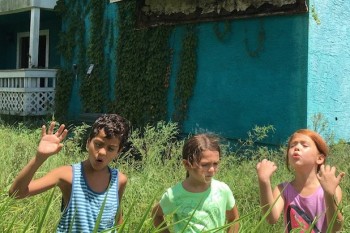
RIVERA, PRINCE AND COTTO IN THE FLORIDA PROJECT
Marginalia
A harsh way to say it is that Baker humanizes sleaze, but this is what artists have been doing since the nineteenth century, inviting the educated classes to enter as fascinated tourists into the lives of classless, powerless, marginal people. Baker made a name by creating a gemlike first film, Tangerine, out of minimal materials in every sense, using an iPhone5 in 2015 with an anamorphic lens attachment and heightening the color (the images still glow in my memory). This time he has in every way gone bigger, shifting to 35mm film and from the world of a transgender prostitute and the fringes of Hollywood to, well, a prostitute and a big purple motel on the edge of Orlando, Florida's Disney World.
But a lot of the time - and this is its key feature - the extraordinary, marginal beings Baker focuses on in The Florida Project are six-year-olds. They are especially Moonee (Brooklynn Kimberly Prince) and her two friends, Scooty (Christopher Rivera), who lives just one floor down, and Jancey (Valeria Cotto), a new girl from a nearby inn called Futureland. The three-storey purple palace of last resort is called the Magic Castle. Its kindly but exasperated manager, who paid $20,000 to have the purple coating applied, is Bobby (Willem Dafoe). (Purple they call it, but as Anthony Lane points out, it's really mauve.)
For many at the Magic Castle this is a place of last resort. Bobby is always yelling "you're outta here" to Moonee's mom, Halley (Bria Vinaite), who is a childish, irresponsible, down-on-her-luck 22-year-old unemployed stripper with big tattoos on her breasts and piercings. She sells perfume illegally with Moonee in tow at nice nearby hotels but, though it's left vague, she's turning to prostitution to make the $38 a day rent at the motel. She also gets free food from behind the Waffle House where Scooty's mom (Mela Murder) works as a waitress. She's understandably hostile to Halley and her son's association with Moonee.
The three kids run wild, while Moonee is allowed with the other two, scamming tourists to get ice cream they haven't the money to pay for, spilling it in the lobby, entering into the rooms that are forbidden and once shutting down the power throughout the motel. They also explore an abandoned building, commenting on how they would redecorate the rooms, and then set fire to it. Moonie often goes back to a stately pleasure dome called Orange World, a gift shop topped off by the head of a giant wizard, and a cone-shaped Twistee Treat. In a world where a kid is lucky not to have fully grasped what the adults are doing (but Moonee is catching on fast), there is much to stimulate the fantasy of a child, despite the tawdriness hovering around the edges. And Moonee acts like a queen, showing off the place to her two pals: she knows her way around. It's summer. No school. Or did she ever go to school? Moonee reigns, anyway.
The Florida Project has a series of crises and incidents rather than a plot. It oscillates between Bobby, Halley, and Moonee, but it enters more into the kids' world than into the adults'. But while the word "adult" is used, when Moonee tells her pals "I can always tell when an adult is going to cry," there are no adults, though Bobby is, maybe, a kindly mother hen. With his images and his entry into foul language of the underclass so far it turns into some kind of rough poetry - but it can still make you wince. Sean Baker is a maker of magic - but not one who beautifies the ugly. The ugliness is all there. But toward the end when the three kids run off to a field of grazing cattle and stare at it, magic and poetry happen.
In the defiance of Moonee and her mother there's a sense of hope but also anger at their situation. Both are young enough not to have given up. In the dramatic final sequence that in a sense pulls all the scattered narrative together, that's even more clear. What Baker is selling us is sympathy and hope, in a region where our first reaction would be to see none. In other words, he is a humanist. Perhaps also a dreamer and fantasist.
What he's also doing is something like the Italian neorealists - but not entirely. They used dubbing: the non-actors who starred didn't have to understand what they were saying. This time it's likely that Bria Vinaite, whose tattoos and piercings are real, may be close in sensibility if not experience to the character and situations she plays in The Florida Project. But she is also acting, and so is the feisty Brooklynn Kimberly Prince. Baker is practicing a particularly artful kind of wrangling with his inexperienced actors and making knowledgeable use of his locations. This has an energy and a shape: more will linger than the color and this gift for marginalia will be known.
The Florida Project, 115 mins., debuted at Cannes May 2017 in Directors Fortnight, listed in 18 international festivals on IMDb, including New York. In theaters starting 6 Oct. 2017. Screened at Angelika Film Center 7 Oct. An A24 release. (Metacritic rating 94%.)
Last edited by Chris Knipp; 10-08-2017 at 04:12 AM.
-
LOVER FOR A DAY/L'AMANT D'UN JOUR (Philipppe Garrel 2017)
PHILIPPE GARREL: LOVER FOR A DAY/L'AMANT D'UN JOUR (2017)
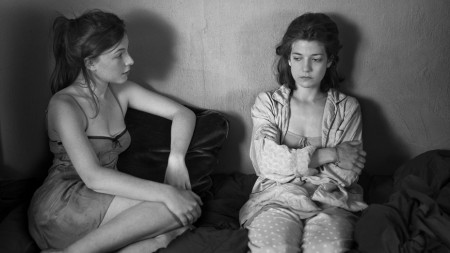
LOUISE CHEVILLOTTE AND ESTHER GARREL IN LOVER FOR A DAY
Daddy issues
Philippe Garrel's new film, Lover for a Day/L'amant d'un jour, looks like a lot of his other work. It's filmed in stark but elegant 'scope black and white and focused on a middle-aged man and two young women. His numerous autobiographical films are much like this. And yet, like the other two in the trilogy this concludes, Jealousy (NYFF 2013) and In the Shadow of Women (NYFF 2015), this seeks to go in a new direction. Oddly enough, it's in a sense filmmaking by committee, with four screenwriting credits, notably two female. The screenwriters were Garrel; his wife the young writer-director Caroline Deruas (L'Indomptée); Maurice Pialat's former partner Arlette Langmann (À nous amours); and Luis Buñuel's prolific writing collaborator Jean-Claude Carrière - a distinguished crew indeed.
Garrel has said the woman's point of view was sought at every point for this film. He remains very much in charge stylistically, but the girls do take center stage. Far from Garrel's dreamy, epic evocation of 1967-68 Regular Lovers (NYFF 2005), this is certainly a relatively slight piece of work, yet the collective writing may conceal layers of complexity. But on the other hand Boyd van Hoeij, in Hollywood Reporter in one of the most perceptive reviews, points out it's the film's "problems with structure" that "keep it from greatness." And that's because it's not clear whose point of view it is.
The movie starts off with a bang, pun intended, a quick connection between a man and a woman in a hallway that concludes in a restroom - with a loud female orgasm. Such realistic lovemaking, and emphasis on the woman's pleasure, is unusual for this director, however sensual his films. Next we see a dark young woman, Jeanne (Garrel's daughter, Esther Garrel, better here than previously, though trying too hard) turn up at the small apartment of her philosophy prof dad, Gilles (Éric Caravaca,) exploding in a hysterical, unstoppable, body-shaking rush of tears. Feeling rejected by her boyfriend, Matéo (Paul Toucang), the first great love of her life, Jeanne has abruptly left him with nowhere else to go. But Jeanne finds out there's somebody else living chez papa, Ariane (Louise Chevillotte, a fresh face), one of her father's students, who's been his live-in lover for three months and is Jeanne's same age, 23.
Jeanne says this is okay. There's not much she could do about it anyway. In fact Ariane and Jeanne bond - sort of, Ariane providing Jeanne first with comfort, later with advice to try lightening up and having a quick affair or two.
Actually, there's something Electra complex-ish going on here, ultimately. The "lover for a day" is Ariane's, a pretty young man called Stéphane (Félix Kysyl), who she has quick stand-up sex with, and Jeanne engineers this relationship by introducing Ariane to him. Gilles immediately finds out about it and is horrified. He tells Ariane she has now turned out not to be the kind of person he had had in mind, though he acknowledges that he used to be like her, and had earlier said the relationship could be open-ended. He calls her now "a female Don Juan." Maybe he should have chosen somebody older? Gilles tells Ariane she has to move out, and Jeanne has the place, and her father, to herself.
Along the way, Garrel finds time in this very brief movie for several group scenes. There's one of dancing, which more briefly achieves some of the magic of the longer, signature sequence of Regular Lovers, along with a discussion by students and older men of the French-Algerian war. Both these show the atemporal quality of Garrel's movies. This one has contemporary notes, but a lot of it could be from the Sixties, the Seventies (the latter in a sense Garrel's heyday) or some other era. A timelessness is contributed by Renato Berta's cinematography. The images of kitchen, bedroom, and sidewalk are familiar ones from previous Garrel films. The notable use of an iPhone, and its context, temselves seem anachronistic.
The movie can be taken various ways, too. Most of the audience was respectful at the big New York Festival screening. Yet there was also constant tittering, not explainable by a the film's moments of intentional self-mockery. There is a certain elegance in Garrel's faithfulness to his resolutely small, personal, obsessive, almost zen focus on love triangles. Still they risk seeming indistinguishable and dispensable. And yet, despite missteps - a suicide attempt, a wrong turn toward porn photos, minor male actors who lack authority - Lover for a Day winds up charming the viewer, as its male anti-heroes do their young women.
Garrel rehearsed the film one day a week for a year, he explained, making the final actual, low-budget shoot fast and smooth. This is a method of more rigor that may also have conveyed more dryness. Was there room left for spontaneity? Sometimes hard not to think, while watching Lover for a Day, of Éric Rohmer's similarly themed yet so very different films, so bright and full of charm and light, technicolor being as essential to them as black and white seems to be to Garrel. Once Garrel had hardly any dialogue, but that distinction is no longer present. Not only do Jeanne and Ariane do plenty of chatting, but voiceovers kept explaining things. However, here the emphasis is on manipulation, though foolish choices, a Rohmer favorite, also feature. You can't claim either director's world is more real, but Garrel's feels harsher.
And yet this time not so much, because there is a happy ending, which happens almost by magic, through a chance meeting on the street.
Lover for a Day/L'amant d'un jour, 76 mins., debuted at Cannes May 2017's Directors Fortnight, where it won the SACD Prize ex aequo with Claire Denis for Let the Sun Shine In. It entered French theaters 31 May (AlloCiné press rating 3.5), also playing in at least eight festivals. Screened for this review at Alice Tully Hall 10 Oct. 2017 as part of the New York Film Festival. Acquired by MUBI for US release coming 19 Jan. 2018. Metascore 76%.
Last edited by Chris Knipp; 10-11-2017 at 09:31 PM.
 Posting Permissions
Posting Permissions
- You may not post new threads
- You may not post replies
- You may not post attachments
- You may not edit your posts
-
Forum Rules





 Reply With Quote
Reply With Quote







Bookmarks